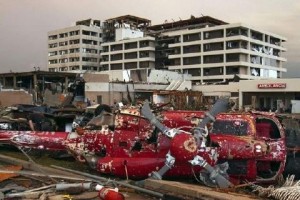But this time it’s real and with deadly consequences.
You’re looking at the damage outside St. John’s Regional Medical Center in Joplin, Missouri, which was in the path of the most powerful kind of tornado there is–an EF-5. This rating means it had wind speeds of at least 200mph as it ripped into Joplin on Sunday evening May 22, 2011.
You can see the windows blown out, some of the walls ripped off. And big and red, the medical Life Flight helicopter that looks like it’s been under fire. And it had been, from a tornado and all the debris the tornado threw around.
Doppler radar from the event showed debris up to 1 mile wide – which usually means the tornado was about that same size. And it showed debris being lifted into the sky up to almost 20,000 feet. That gives you an idea of the power of this particular super-cell thunderstorm.
Joplin Tornado One Of The Deadliest Single Tornadoes In U.S. History – Updated
We’ve heard about the horrific death tolls this spring after tornado outbreaks, where dozens or even more than one hundred tornadoes hit in a single stretch of severe weather.
But this Joplin, Missouri tornado appears to be just one tornado that hit a big slice of the city head on, making it one of the deadliest single tornadoes in U.S. History. Here’s the list of deadliest tornadoes that are ranked nearest the death toll from Joplin’s tornado (as of May 28, 2011):
- #7 – 151 killed – Joplin, Missouri (May 2011)
- #8Â -Â 143killed – Amite, LA & Purvis, MS ( April 1908)
- #9Â -Â 117 killed – New Richmond, Wisconsin (June 1899)
- #10 – 115 killed – Flint, Michigan (June 1953)
- #11 – 114 killed – Waco, Texas (May 1953)
- #11 -Â 114 killed – Goliad, Texas (May 1902)Â
I appreciated an email from Koin Local 6 Morning and Noon Meteorologist Matt Brode, putting something about this list into perspective. He pointed out that virtually all of these deadliest single tornadoes are from long ago. “With all of the warnings, sirens and radar has improved so much over the years. We typically don’t see so many deaths from a single tornado.”
Matt’s absolutely right. And it raises a bunch of questions that will be looked at by tornado investigators along with local officials. Was the warning so short people did not have time to move to safety? Did sirens work so that areas about to be hit could hear them? Are people so used to tornado warnings that it’s just kind of ‘another day’ when the sirens sound and nothing too urgent?
We’ll find out more in the days to come.
In the meantime, let’s send our thoughts and prayers to the people of Joplin as they try to pick up the pieces after such a tragedy.


Thanks for this article, this is very useful for me. regards..